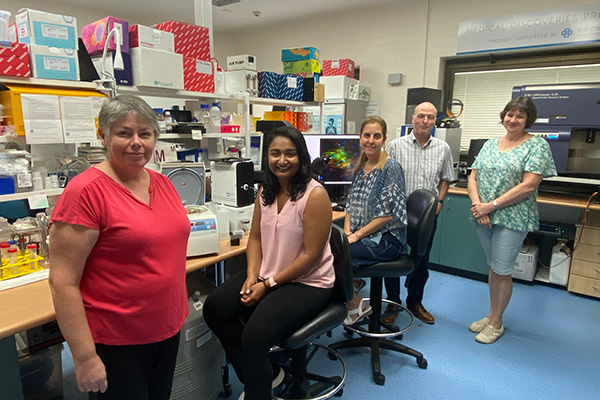Nature may hold key to life affecting lung disease
Researchers at TPCH are investigating the possibility that a North Queensland rainforest tree may hold the key to treating and reversing lung fibrosis, a serious life-threatening disease causing scarring in the lungs.
Pulmonary or lung fibrosis is a progressive condition that affects more than three million people globally. Idiopathic pulmonary fibrosis (IPF) is the most common and lethal form and people with the disease experience breathlessness, which worsens over time. The median survival after diagnosis is between two and five years and at present the disease trajectory for patients with IPF ends with death or lung transplantation.

Bringing nature to research – members of the Queensland Lung Transplant Service research team.
With no definitive curative treatment for lung fibrosis currently available, lung researchers Dr Simon Apte and Professor Dan Chambers, with colleagues from the Queensland Lung Transplant Service research laboratory at TPCH, have developed an innovative method to identify drugs that may prove useful in the treatment of lung fibrosis.
The method involves using two existing research programs, including the team’s ongoing trial of whole lung lavage for the treatment of silicosis. This involves washing out the lungs of silicosis patients with up to 30 litres of fluid, producing billions of important cells known as alveolar macrophages.
“Instead of throwing these cells away, we recovered them from the lavage fluid, stored them, and preserved them, which allowed us to use them for research,” Dr Apte said.
The second research program uses ground breaking single cell RNA sequencing technology to identify the characteristics of the cells driving fibrosis in the lungs of Idiopathic Pulmonary Fibrosis (IPF) patients.
“Single cell sequencing allows us to create a very high-resolution picture of what’s going on in the lungs of patients with IPF, and using that technology, we can identify ‘bad’ cells that are driving lung fibrosis,” Dr Apte said.
“Importantly, we can now identify the elements we need to change in those cells, and see whether a drug could reprogram these cells from ‘bad’ to ‘good’.
“However, one of the biggest challenges researchers and clinicians face is that there are no existing drugs that can effectively halt or reverse lung fibrosis. Since so few potential drugs are available, we needed to find a way to discover completely new drugs,” Dr Apte said.
Dr Apte and his team turned to NatureBank at the Griffith Institute for Drug Discovery (GRIDD). NatureBank is Australia’s largest biodiscovery resource containing more than 30,000 archived Australian flora and fauna samples, which have been processed into extract, fraction and pure compound drug discovery libraries.
Manager for NatureBank and GRIDD Research Leader Associate Professor Rohan Davis said that NatureBank accelerates biodiscovery by providing researchers from around the world with access to natural compounds with high potential for development into new drugs.
“Through NatureBank, and the wonderfully unique chemistry it contains, we were able to provide the QLTS research team with a number of natural compounds that could be tested for their potential use in treating lung fibrosis,” Assoc Prof Davis said.
Using compounds from NatureBank, and with philanthropic support, the Queensland Lung Transplant Service research team was able to employ highly experienced scientist Penny Groves to run numerous drug discovery assays, to test the ability of the compounds to reprogram the alveolar macrophages and stop them from driving fibrosis.
In particular, one of the compounds isolated and supplied by Assoc Prof Davis from the roots of a rainforest tree native to Queensland has shown great promise, and Penny is busy screening similar compounds looking for greater activity.
“We are very excited about this discovery as it could mean a new life saving treatment option for patients with lung fibrosis,” Dr Apte said.
This research is funded by The Common Good, an initiative of The Prince Charles Hospital Foundation.
